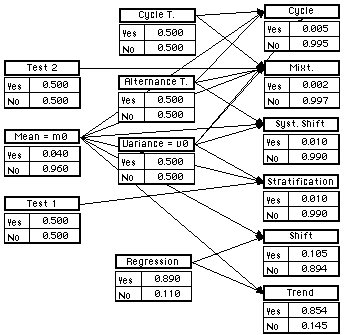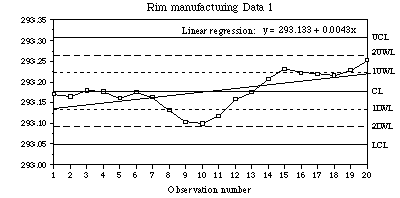
The expert system gives a high probability (0.854) for the trend pattern. This can be confirmed by using standard statistical techniques, as shown in the next figure.

In this paper we introduce a new methodology for expert systems in the field of quality control. Rule-based expert systems are substituted for more general probabilistic network models which allow us to handle uncertainty. Deterministic tests, as hypothesis tests, used in previous models are also replaced by probabilistic specifications that provide complete information about the characteristics of the process. The new tests enhance the existing models and allow the probabilistic expert system to obtain reliable conclusions even with partial information. Some boundary problems arising from deterministic outputs of the hypothesis tests are also fixed. The main advantages of this new methodology are its ability to deal with uncertainty and partial information, and the possibility of obtaining a confidence measure associated with the diagnosis. A real life example arising in rim manufacturing is used to analyze the performance of this method.
Quality control is concerned with the identification and control of irregular behavior in production processes. The basic idea of standard quality control methods consists of identifying irregular patterns associated with a given observation data group. To do this, several tests involving statistical techniques and graphical representations (X-charts, CUSUM-charts, etc) are performed on the observations. These tests compare the observation data corresponding to a small period of time with the "process data", which gathers information over a long period of time.
Any of the above patterns can be associated with a group of "assignable causes" of irregularity, that is, causes that disturb the process and whose presence can be derived from the behavior of the system. Some examples of these causes are: changes in materials or operators, machinery setting, careless handling, etc. The goal of quality control systems is to compute the assignable causes associated with out-of-control processes. For general information about this subject the reader may consult the books of Grant (Statistical Quality Control. McGraw-Hill, 1988) and Western Electric (Statistical Quality Control Handbook. Western Electric, 1958).
In recent years, rule-based expert systems have been introduced as a useful tool to solve this problem. However, this type of expert system can only deal with deterministic situations. A certain deterministic output (true or false) has to be assigned to each of several performed tests. Due the deterministic character of hypothesis tests (of the mean, of the variance, etc.), these type of tests are widely used in combination with rule-based experts systems in this field. These tests provide the rule-based expert system with a deterministic value needed to perform the inference process by chaining the different rules included in the knowledge base. In this paper, we introduce probabilistic expert systems which generalize this methodology avoiding the problems associated with the deterministic character of rule-based expert systems. Now, the tests are assigned a probability according P(H0) and P(H1), indicating the degree of membership to any of the two hypotheses. Note that the deterministic hypothesis test is a particular case of this probabilistic scheme, where we can only obtain extreme probabilities: P(H0)=0, P(H1)=1 or P(H0)=1, P(H1)=0. However, in a general situation, the probabilities P(H0)=p, P(H1)=1-p, are valuable information for the expert system.
For example, the following Bayesian network gives the result of applying the expert system to a given situation in which a tren pattern is present:

The expert system gives a high probability (0.854) for the trend pattern. This can be confirmed by using standard statistical techniques, as shown in the next figure.
